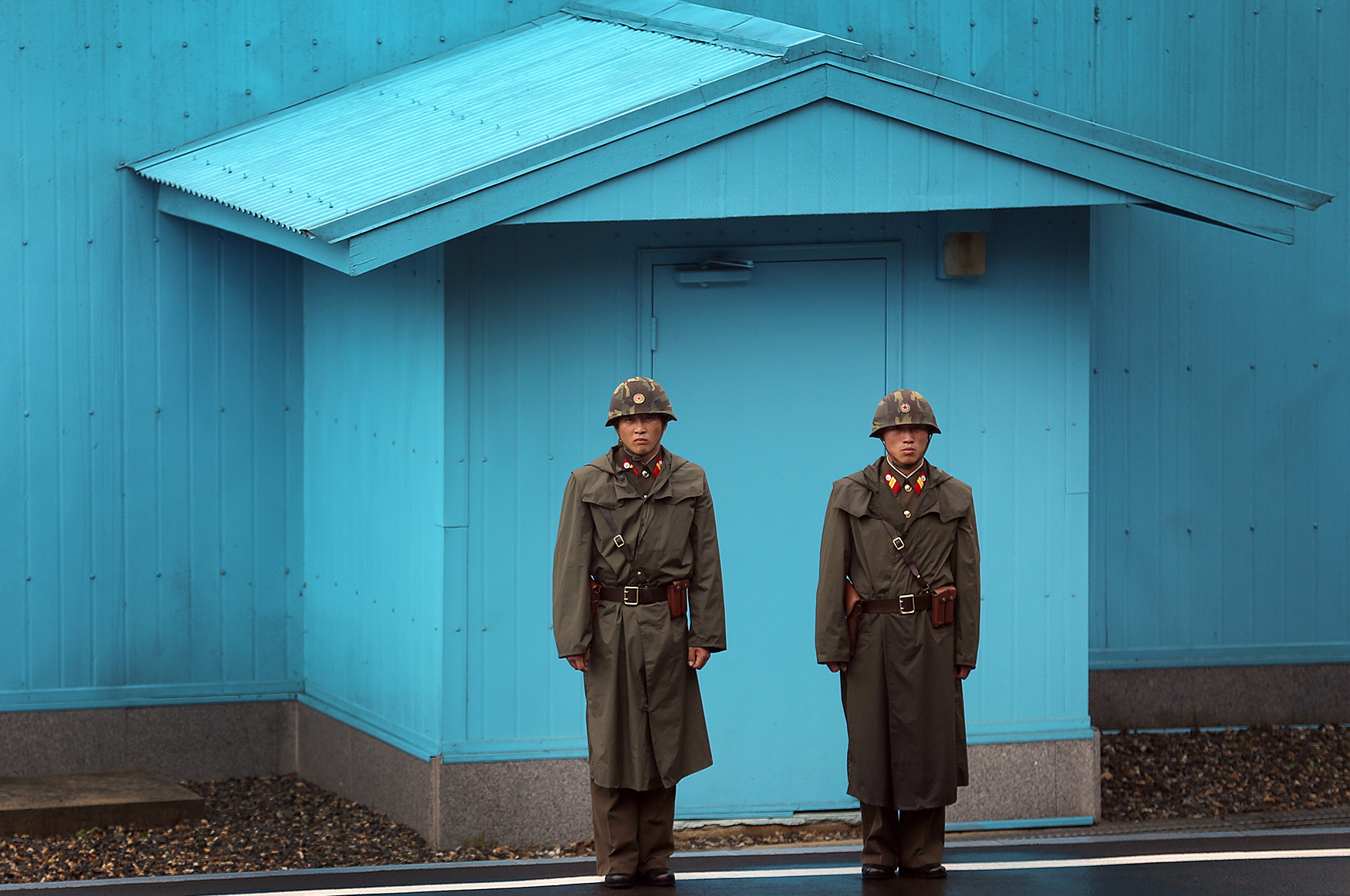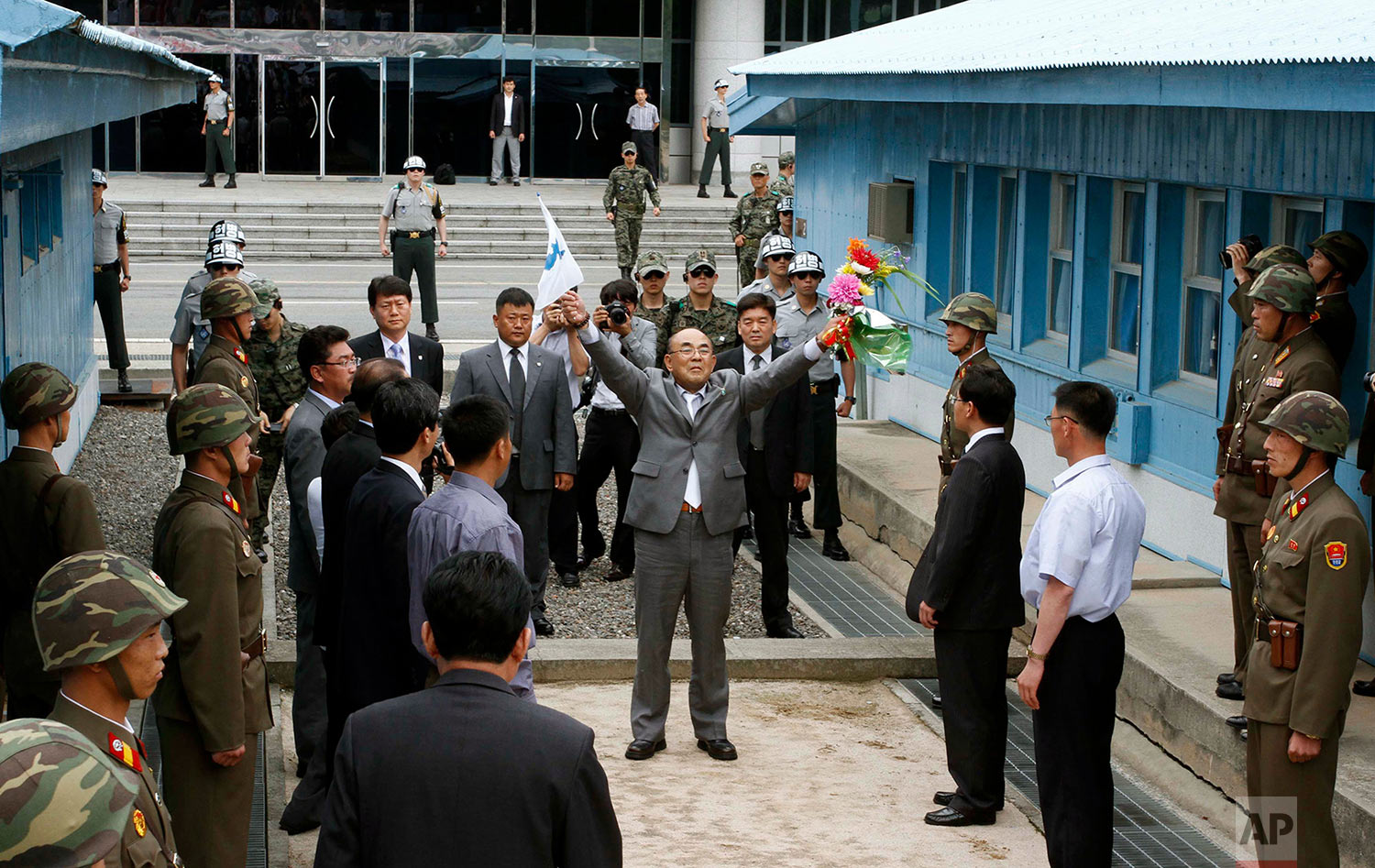North Korea: DMZ

For more than 60 years, the artificial dividing line between the two Koreas has separated families and stood as a testament to hostilities that have seemed to have no end. The Demilitarized Zone, despite its name, remains the world’s most heavily fortified border.

Walking past United Nations and North Korean guards on duty, sightseers flock around the building in which the Military Armistice Commission meets in the Demilitarized Zone at Panmunjom, Korea, on July 8, 1963. (AP Photo/KIM)

American soldiers patrol along a ridge between observation towers at Ouellette, the northernmost outpost in Korea's Demilitarized Zone manned by U.S. forces, on Sept. 22, 1977. (AP Photo/MD)

U.S. Vice Admiral Warren Hamm Jr., right, the senior negotiator for the United Nations Command, speaks at the 391st Military Armistice Commission (MAC) meeting at Panmunjom, Korea, on Oct. 27, 1978. Vice Adm. Hamm accused North Korea of digging an underground tunnel in the Demilitarized Zone into South Korea. At left is North Korean army Maj. Gen. Han Ju-Kyong, the North's chief MAC delegate. (AP Photo)

U.S. President Ronald Reagan looks at positions in North Korea from the South Korean side of the Demilitarized Zone on Nov. 13, 1983. (AP Photo/Scott Stewart)

Soldiers stand guard at the area known as Conference Row in Panmunjom, Korea, with North Korea's Panmun-gak building in the background in 1988. (AP Photo)

A North Korean army officer films through a window at a meeting of the Military Armistice Commission in Seoul, South Korea, on Sept. 12, 1989, as other communist officials listen. (AP Photo/Yun Jai-Hyoung)

South Korean soldiers take their position along the wire fence in the Demilitarized Zone separating the two Koreas near the truce village of Panmunjom on April 8, 1996, the day after armed North Korean troops marched into the DMZ. (AP Photo/Ahn Young-joon)

South Korean students look across the Demilitarized Zone between the two Koreas at the guard post of Imjingak, north of Seoul, Friday, Oct. 17, 1997. Earlier that day, North Korean soldiers crossed into the southern half of the buffer zone, seizing two South Korean farmers in a rice field and taking them back to the northern side. The farmers were returned soon afterward. (AP Photo/Yun Jai-hyoung)

U.S. President George W. Bush, right, looks out at North Korea from Observation Point Ouellette in the Demilitarized Zone, the tense military border between the two Koreas, in Panmunjom, Korea, on Feb. 20, 2002. Bush's visit to the DMZ came a few weeks after he labeled North Korea part of an "axis of evil." (AP Photo/J. Scott Applewhite)

A North Korean soldier stands guard on the north side of the line separating North and South Korea in the border town of Panmunjom on May 19, 2006. (AP Photo/Wally Santana)

A model of the Demilitarized Zone that separates the two halves of the Korean peninsula is displayed near Kaesong, North Korea, on Sept. 18, 2008. (AP Photo/David Guttenfelder)

President Barack Obama, left, uses binoculars to see North Korea from Observation Post Ouellette in the Demilitarized Zone, the tense military border between the two Koreas, in Panmunjom on March 25, 2012. (AP Photo/Pablo Martinez Monsivais)

North Korea's flag flies on a tower high above the village of Ki Jong Dong, as seen from Observation Post Ouellette in the Demilitarized Zone, the tense military border between the two Koreas, in Panmunjom, Korea, on March 25, 2012. (AP Photo/Susan Walsh)

Activist No Su-hui, center, shouts "Long Live Reunification" in front of North Korean officials and soldiers, foreground, before crossing the demarcation line between North and South Korea where South Korean officials were waiting for him, at the Demilitarized Zone at Panmunjom, Korea, on July 5, 2012. South Korean officials immediately detained the activist for making an extended trip to Pyongyang without South Korean government approval as required by law. (AP Photo/Kim Kwang Hyon)

Surveillance cameras on the South Korean side of the Demilitarized Zone face the truce village of Panmunjom, Korea, on July 22, 2013. (AP Photo/Wong Maye-E)

A soldier walks toward the truce village of Panmunjom on the North Korean side of the Demilitarized Zone that divides the two Koreas on July 22, 2013. (AP Photo/Wong Maye-E)

U.S. Gen. Vincent Brooks, right, commander of the United Nations Command, U.S. Forces Korea and Combined Forces Command, briefs U.S. Vice President Mike Pence, as Pence's wife Karen, left, and their daughters Audrey, second from left, and Charlotte, third from left, listen from Observation Post Ouellette in the Demilitarized Zone near the border village of Panmunjom, Korea, on April 17, 2017. (AP Photo/Lee Jin-man)

North Korean soldiers watch the south side as United Nations Command officials visit after a commemorative ceremony to mark the 64th anniversary of the signing of the Korean War Armistice Agreement at the truce village of Panmunjom in the Demilitarized Zone dividing the two Koreas on July 27, 2017. The armistice agreement on July 27, 1953 brought three years of active combat in the Korean War to a halt, but the two Koreas are still technically at war as no formal peace treaty was signed. (Jung Yeon-Je/Pool Photo via AP)

A North Korean army officer looks out at the Demilitarized Zone that separates the two Koreas in Panmunjom, Korea, on Feb. 22, 2016. (AP Photo/Wong Maye-E)

The North Korean village of Gijungdong is seen during a press tour from the Taesungdong freedom village inside the Demilitarized Zone between North and South Korea in Paju, South Korea, on April 24, 2018. (AP Photo/Lee Jin-man)

North Korean soldiers march at the border village of Panmunjom in the Demilitarized Zone that divides North and South Korea on April 18, 2018. (AP Photo/Lee Jin-man)

North Korean leader Kim Jong Un, left, and South Korean President Moon Jae-in cross the military demarcation line at the border village of Panmunjom in the Demilitarized Zone that divides the North and South on April 27, 2018. (Korea Summit Press Pool via AP)
North Korea Galleries
The headlines are all about nuclear weapons and ballistic missile launches. But on the ground in North Korea, scenes of daily life attest to both the poignancy and resilience of a people struggling to succeed.
Along with its famous mass games, North Korea has taken the tradition of the military parade to a level all of its own. Its parades are used to show off the best and newest weapons in its arsenal and the almost-unhuman precision of its goose-stepping troops.
As the heroes of socialist propaganda, they are depicted as a self-sacrificing, proud proletariat upon whom the weight of the nation is said to depend. But the life of the worker in North Korea has never been easy.
In the totalitarian world of Kim Jong Un’s North Korea, everything begins from the center of Kim Il Sung Square, Pyongyang’s physical and spiritual center. And every neighborhood, it seems, has some sort of a statue or monument in honor of the Kim’s and the nation their created.
Grassroots barter and trade that began as a necessity in the famine years of the 1990s has grown into a quasi-legal market system that is now one of the most important drivers of North Korea’s domestic economy. For those who know how to navigate it, called the “money masters”, there are riches to be had.
For more than 60 years, the artificial dividing line between the two Koreas has separated families and stood as a testament to hostilities that have seemed to have no end. The Demilitarized Zone, despite its name, remains the world’s most heavily fortified border.
Visual artist and Journalist






Kim Jong Un is the third generation of North Korea’s ruling Kim family, the first and now only hereditary socialist dynasty. But while still in his early thirties, he appears to be as deft with wielding power as his grandfather, “eternal president” Kim Il Sung, and father, “Dear Leader” Kim Jong Il.